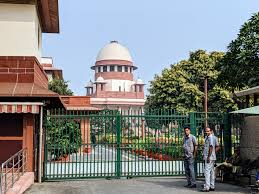This judgment interprets relevant provisions of the Electricity Act, 2003[For short, “Act”.] and Rule 3 of the Electricity Rules, 2005[For short, “Rules”], for being classified as a Captive Generating Plant[For short, “CGP] and a captive user. (Para 1)
We would also like to reproduce Rule 3 of the Rules10, interpretation of which is pivotal for the decision:
“3. Requirements of Captive Generating Plant.—
(1) No power plant shall qualify as a ‘captive generating plant’ under Section 9 read with clause (8) of Section 2 of the Act unless—
(a) in case of a power plant—
(i) not less than twenty-six per cent of the ownership is held by the captive user(s); and 10 As amended up to 01.09.2023.
(ii) not less than fifty-one per cent of the aggregate electricity generated in such plant, determined on an annual basis, is consumed for the captive use: Provided that in case of power plant set up by registered cooperative society, the conditions mentioned under paragraphs at (i) and (ii) above shall be satisfied collectively by the members of the cooperative society: Provided further that in case of association of persons, the captive user(s) shall hold not less than twenty-six per cent of the ownership of the plant in aggregate and such captive user(s) shall consume not less than fifty-one per cent of the electricity generated, determined on an annual basis, in proportion to their shares in ownership of the power plant within a variation not exceeding ten per cent;
(b) in case of a generating station owned by a company formed as special purpose vehicle for such generating station, a unit or units of such generating station identified for captive use and not the entire generating station satisfy(ies) the conditions contained in paragraphs (i) and (ii) of sub-clause (a) above including—
Explanation.—(1) The electricity required to be consumed by captive users shall be determined with reference to such generating unit or units in aggregate identified for captive use and not with reference to generating station as a whole; and
(2) The equity shares to be held by the captive user(s) in the generating station shall not be less than twenty-six per cent of the proportionate of the equity of the company related to the generating unit or units identified as the captive generating plant.
Illustration.— In a generating station with two units of 50 MW each namely Units A and B, one unit of 50 MW namely Unit A may be identified as the Captive Generating Plant. The captive users shall hold not less than thirteen per cent of the equity shares in the company (being the twenty-six per cent proportionate to Unit A of 50 MW) and not less than fifty-one per cent of the electricity generated in Unit A determined on an annual basis is to be consumed by the captive users.
(2) It shall be the obligation of the captive users to ensure that the consumption by the Captive Users at the percentages mentioned in sub-clauses (a) and (b) of sub-rule (1) above is maintained and in case the minimum percentage of captive use is not complied with in any year, the entire electricity generated shall be treated as if it is a supply of electricity by a generating company.
(3) The captive status of such generating plants, where captive generating plant and its captive user(s) are located in more than one state, shall be verified by the Central Electricity Authority as per the procedure issued by the Authority with the approval of the Central Government.
Explanation.—(1) For the purpose of this rule,— (a) ‘Annual Basis’ shall be determined based on a financial year; (b) ‘captive user’ shall mean the end user of the electricity generated in a Captive Generating Plant and the term “captive use” shall be construed accordingly: Provided that the consumption of electricity by the captive user may be either directly or through Energy Storage System: Provided further that the consumption by a subsidiary company as defined in clause (87) of Section 2 of the Companies Act, 2013 (18 of 2013) or the holding company as defined in clause (46) of Section 2 of the Companies Act, 2013 (18 of 2013), of a company which is a captive user, shall also be admissible as captive consumption by the captive user; (c) ‘Ownership’ in relation to a generating station or power plant set up by a company or any other body corporate shall mean the equity share capital with voting rights. In other cases ownership shall mean proprietary interest and control over the generating station or power plant; (d) ‘Special Purpose Vehicle’ shall mean a legal entity owning, operating and maintaining a generating station and with no other business or activity to be engaged in by the legal entity.” (Para 5)
On a conjoint reading of Section 2(8) and Section 2(49) of the Act, a CGP can be an individual, body corporate, association or body of individuals, whether incorporated or not, “primarily for his own use” and “primarily for use of the members of the co-operative society or association of persons”. An association of body corporates is permitted to set up a CGP. (Para 8)
Section 9 read with the relevant provisions of the Act, therefore, postulates three situations. First, when the person who constructs, maintains or operates a CGP for their own use and supplies electricity to himself through dedicated transmission lines. Secondly, when the person who constructs, maintains or operates a CGP to supply electricity by exercising their right to open access for the purpose of carrying electricity from their CGP to the destination of their use. Thirdly, when the electricity generated from the CGP is supplied through the grid for any licensee or consumer. While no license is required for the supply of electricity to a licensee or consumer, the supply is subject to the regulations made under Section 42(2) of the Act. (Para 13)
This brings us to the core issue which relates to interpretation of Rule 3 of the Rules. Three issues arise for our specific consideration in view of the conflicting judgments of the APTEL. These are:
I. Eligibility criteria for a CGP/captive user under Rule 3(1)(a) of the Rules.
II. Interpretation of the second proviso under Rule 3(1)(a) of the Rules and in particular the words “association of persons”. III. Whether a company set up as a Special Purpose Vehicle[For short, “SPV”.] for generating electricity is an, “association of persons”, in terms of the second proviso to Rule 3(1)(a) of the Rules. Issue I Eligibility criteria for a CGP/captive user specified under Rule 3(1)(a) of the Rules. (Para 21)
In the light of what has been discussed by this Court in Global Energy Ltd. (supra) when we examine definition of Generating Plant in section 2(8) of the Act it emphasizes setting up primarily for his own use or in case of cooperative society for use by its members. When we consider Rule 3(1)(a)(ii) of the Rules of 2005, it is clear that it provides not less than 51% of aggregate electricity generated in such plant determined on annual basis is consumed for captive use. The rule conforms to the requirement of section 2(8) that primarily electricity should be generated by captive generating plant for his own use/members as the case may be. The provisions of Rule 3(1)(a)(ii) of the Rules of 2005 cannot be said to be against purposes of the Act. Rather it promotes rationale of the provision and essential qualifications laid down in the Act itself (Para 63)
An association of companies or body corporates thus are required to comply with Rule 3(1)(a) read with the second proviso to Rule 3(1)(a). Equally, an association of companies, body corporates, or other persons that set up a SPV which owns, maintains, and operates a CGP is required to comply with Rule 3(1)(a) read with the second proviso to Rule 3(1)(a). A SPV in this regard may be company, but it also is also an association of persons in terms of the second proviso to Rule 3(1)(a). (Para 64)
We cannot, in any manner, read Rule 3(1)(b) as overriding or prevailing over Rule 3(1)(a) of the Rules. To accept this argument would, in fact, be accepting that “gaming”, as described above, is permissible if a company is formed as a SPV for the purpose of generating and supplying electricity to its shareholders or other body corporates. For instance, a generating company established as an independent power producer being a shareholder of 98% shares in a plant can camouflage as a CGP by giving 2% shares to group captive users and allowing them to consume 98% of the electricity generated. The independent power producer may consume only 2% of the electricity generated despite holding 98% of the shares in the plant. This would be clearly contrary to Section 2(8), which uses the expression, “primarily for its own use”. To accept this submission would also be contrary to the object and purpose behind giving benefit to captive users who spend their money and invest in setting up a CGP. While interpreting a provision which is ambiguous or debatable, the court or the adjudicator must keep in mind the intent of the legislature and read the words in a manner that the object and purpose is promoted, rather than accepting an interpretation which would result in misuse or abuse. (Para 65)
SUPREME COURT OF INDIA
2023 STPL(Web) 324 SC
[2023 INSC 886]
M/S. Dakshin Gujarat Vij Company Limited Vs. M/S. Gayatri Shakti Paper And Board Limited And Another, Etc.
Civil Appeal Nos. 8527-8529 Of 2009 with Civil Appeal Nos. 1-2 Of 2010 Civil Appeal Nos. 1693-1698 Of 2010 Civil Appeal No. 12282 Of 2016 Civil Appeal No. 1142 Of 2022 Civil Appeal No. 1141 Of 2022 Civil Appeal Nos. 4611-4624 Of 2022 Civil Appeal Nos. 4532-4556 Of 2022 Civil Appeal No. 4571 Of 2022 Civil Appeal Diary No. 10378 Of 2022 Civil Appeal No. 3662 Of 2022 Civil Appeal No. 4233 Of 2022 And Civil Appeal No. 8738 Of 2022-Decided on 9-10-2023
https://stpllaw.in/wp-content/uploads/2023/10/2023-STPLWeb-324-SC.pdf








